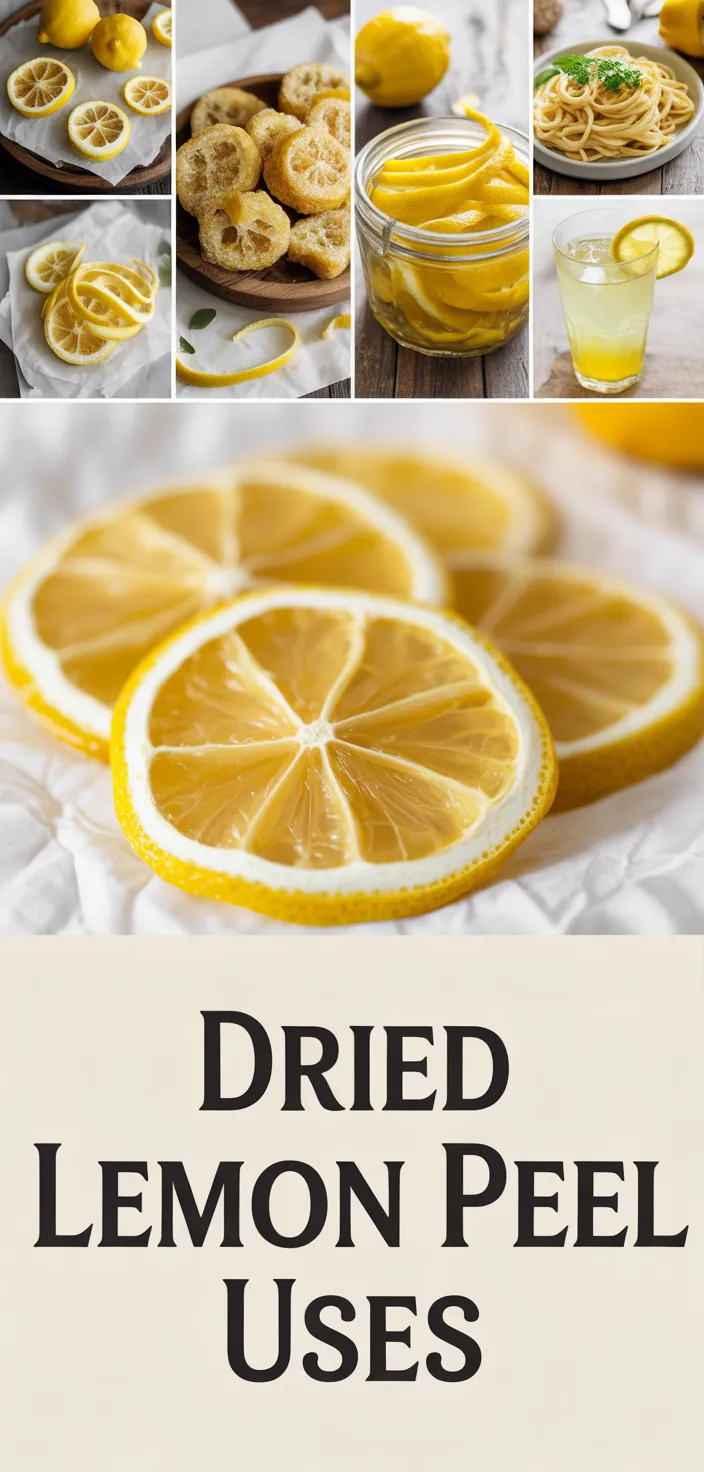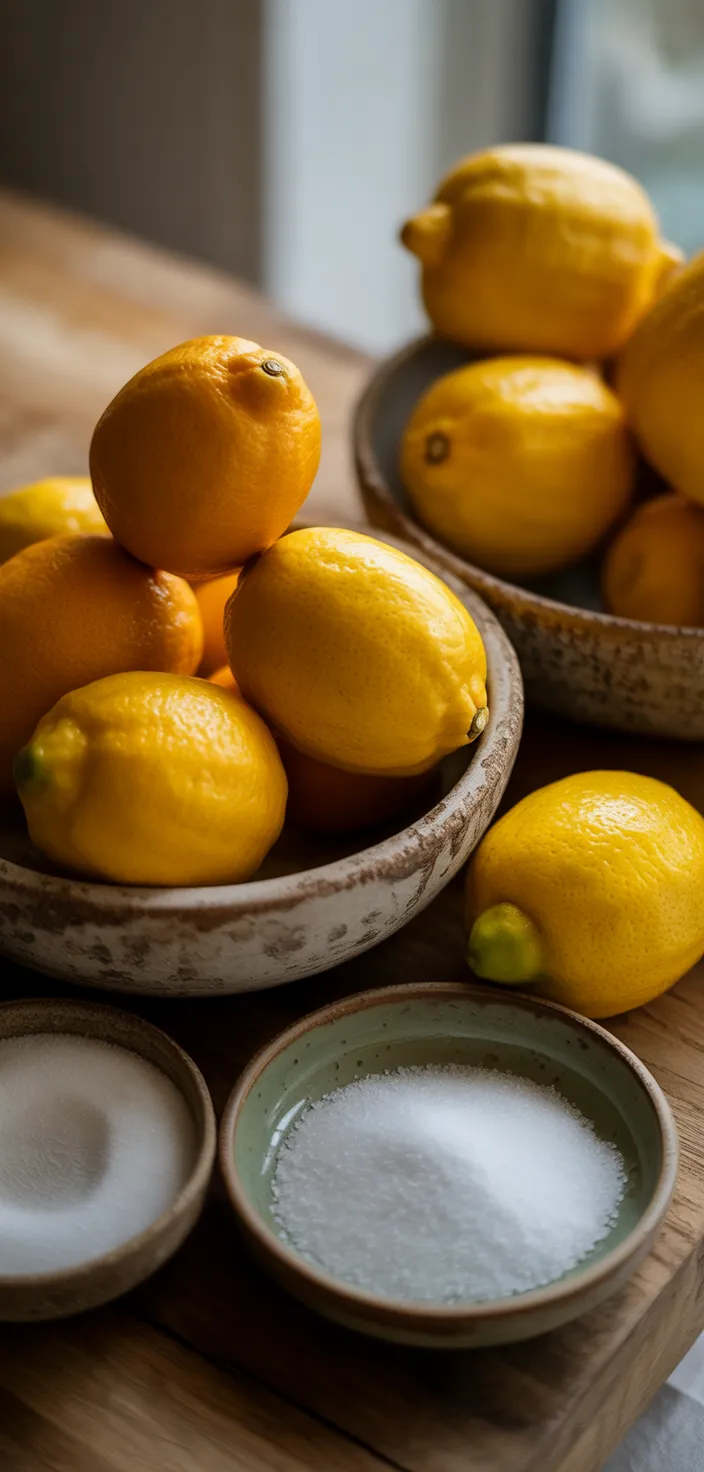I explore Dried Lemon Peel and the unexpected roles it can play from recipes to natural cleaning and pantry mixes.

I keep a jar of sunlit peels on my shelf. I use organic unwaxed lemons, and sometimes a touch of granulated sugar when I want sweet notes, but mostly it’s the tang that surprises me.
What fascinates me is how a handful of Dried Lemon Peel can flip a dish or cup into something unexpectedly lively. It’s not just about flavor, there’s an entire world of Lemon Uses you don’t think about until you have this stash.
I forget about jars, then find them again and wonder why I didn’t start sooner. You’ll want to try it, trust me.
Ingredients

- Lemons: bright peel rich in vitamin C, aromatic oils, adds sour, low calories.
- Lemon pith: bitter, higher fiber, astringent, helps gut, not usually eaten raw.
- Dried lemon peel: concentrated zest, intense aroma, little calories, boosts teas and baking.
- Granulated sugar: adds sweetness, simple carbs, energy dense, can candy peels for treats.
- Citric acid: intensifies tartness, preserves color, adds acidic bite, helps shelf life.
- Coarse sea salt: brings savory depth, minerals, salt reduces bitterness, great in rubs.
- Organic unwaxed lemons: skin better for drying, less chemicals, safer to eat peel.
Ingredient Quantities
- About 4 to 6 medium organic lemons unwaxed if possible
- Optional 1/4 to 1/2 cup granulated sugar for candied or sweet peel
- Optional 1 teaspoon citric acid to help preserve color and add tartness
- Optional 1/4 cup coarse sea salt for savory blends
How to Make this
1. Wash about 4 to 6 medium organic lemons well, pat dry, then remove the yellow peel with a vegetable peeler or sharp knife, trying to leave as much of the white pith behind as you can because pith = bitter.
2. If you want less bitterness, blanch the peels: drop them in boiling water for 30 to 60 seconds, drain and repeat 2 more times, that little rinse trick really helps.
3. For candied or sweet peels use 1/4 to 1/2 cup granulated sugar: make a simple syrup with equal parts water and the sugar you choose, simmer peels in the syrup 15 to 25 minutes until translucent, lift out, let excess syrup drip off then toss in extra sugar and lay on a rack to finish drying.
4. To preserve color and add brightness dissolve about 1 teaspoon citric acid in a couple tablespoons of water and either add it to the final blanch or stir it into the syrup; it helps stop browning and gives a nice tart snap.
5. For savory peels sprinkle or toss dried or just-dried peels with up to 1/4 cup coarse sea salt to make a lemony finishing salt or fold the salt into chopped dried peels for rubs and marinades.
6. Dry the peels until fully crisp: use a dehydrator set about 95 to 115 F for 6 to 12 hours, or an oven set to its lowest around 170 F (77 C) with the door propped open a little to let moisture escape, check and turn peels every 30 to 60 minutes so they dry evenly, they should snap when done.
7. Quick hack if you need peel fast: microwave single layer between paper towels in 20 to 30 second bursts checking often, it works but watch closely so they do not burn.
8. Let peels cool completely, then decide form: leave whole strips for garnishes, chop for blends, or grind to a powder in a spice grinder or mortar and pestle for zesting in recipes.
9. Store in an airtight jar in a cool dark place up to about 6 months for best flavor, or freeze for longer storage; label with date so you know when you made them.
10. Uses and final tips: add powdered peel to baked goods, tea, rubs, dressings and cocktails; candied peels make great garnishes or snackable sweets, and if any peels smell off or are spotted throw them out, better safe than sorry.
Equipment Needed
1. Vegetable peeler or small sharp paring knife, to remove just the yellow peel
2. Cutting board, sturdy and easy to clean
3. Small to medium saucepan for blanching and making syrup
4. Slotted spoon or tongs to lift peels out of hot water or syrup
5. Fine-mesh sieve or colander to drain blanched peels
6. Cooling rack for drying and candied peels to finish crisping
7. Rimmed baking sheet (use with the rack or for oven drying)
8. Dehydrator or an oven that can run at a low temp
9. Microwave-safe plate and paper towels if you want the quick hack
10. Spice grinder or mortar and pestle and airtight jars for powdered peel and storage
FAQ
Learn To Make And Use Dried Lemon Peels Recipe Substitutions and Variations
Learn To Make And Use Dried Lemon Peels
Ingredients
- About 4 to 6 medium organic lemons unwaxed if possible
- Optional 1/4 to 1/2 cup granulated sugar for candied or sweet peel
- Optional 1 teaspoon citric acid to help preserve color and add tartness
- Optional 1/4 cup coarse sea salt for savory blends
Quick gear and prep
– A vegetable peeler or microplane zester, baking sheet and parchment, or a dehydrator.
– Wash lemons well, dry them, then remove only the yellow zest. Try to avoid the white pith, it tastes bitter.
– If you want candied peels, toss the strips in sugar or simmer in simple syrup first, then dry.
How to dry (3 easy ways)
1. Oven: preheat to the lowest setting you can, about 140 to 160°F (60 to 70°C). Lay peels on parchment, bake 1.5 to 3 hours until brittle, flipping once. Watch closely near the end so they don’t burn.
2. Dehydrator: single layer at 125°F (52°C) for 4 to 8 hours depending on thickness.
3. Air dry: spread in a single layer on a rack in a warm, dry spot for several days. Cover with cheesecloth to keep bugs off.
Finishing and uses
– Once fully dry, break into pieces, or pulse in a spice grinder to make lemon powder.
– Use in baked goods, salad dressings, flavored salts or sugars, tea blends, marinades, or cocktails.
– To make lemon sugar: mix 1 part finely ground dried peel with 4 parts granulated sugar, store in an airtight jar.
– For lemon salt: mix crushed dried peel with coarse salt, spread to dry a day, then store.
Storage
– Keep in airtight jars in a cool, dark cupboard. Dried peels last 6 to 12 months and keep most of their aroma.
– If you candied them first, store like candy, but they’ll be stickier and may need extra drying.
Tips and common mistakes
– Don’t toss the pith free cuts in, it will ruin the flavor. If you do get some pith, scrape it off with a knife.
– If you want brighter color, briefly soak peels in a mild citric acid solution or lemon juice before drying.
– Grind when fully brittle. Slight moisture will gum up your grinder.
Substitutions
- Lemons: substitute limes, oranges, or grapefruit for similar citrus zest. Limes are closest in tang, oranges give sweeter notes, grapefruit is more floral.
- Granulated sugar (for candied): use caster or superfine sugar, or light brown sugar for deeper flavor. If using syrupy sweeteners like honey you’ll need longer drying time and a stickier result.
- Citric acid: substitute ascorbic acid (vitamin C powder) or lemon powder for color preservation and tartness. Fresh lemon juice works too for candying but adds moisture so dry longer.
- Coarse sea salt: use kosher salt, flaky Maldon, or smoked salt for a flavor twist. If swapping by volume, note kosher salt grains are lighter so measure by weight when possible.
Go on, try a batch. Once you start, you’ll find dried lemon peel sneaks into everything and makes simple dishes sing.
Pro Tips
1. Use unwaxed lemons and peel thinly with a very sharp peeler, rolling the lemon under your palm first to loosen the oils, that way you get more fragrant zest and less bitter pith.
2. If you hate bitterness, blanch peels quickly 2 or 3 times, and add a little citric acid or a squeeze of lemon to the last rinse to keep the color bright, it really makes a difference.
3. For candied peel, simmer gently until translucent then give them a quick sugar toss and slow dry on a rack; low steady heat is better than high heat, watch them closely so they dont caramelize and turn bitter.
4. Store completely cool peels in an airtight jar in a dark, cool place and label the date, or freeze for long storage; grind some into powder for baking and cocktails, and toss any peels that smell off, better safe than sorry.
Learn To Make And Use Dried Lemon Peels Recipe
My favorite Learn To Make And Use Dried Lemon Peels Recipe
Equipment Needed:
1. Vegetable peeler or small sharp paring knife, to remove just the yellow peel
2. Cutting board, sturdy and easy to clean
3. Small to medium saucepan for blanching and making syrup
4. Slotted spoon or tongs to lift peels out of hot water or syrup
5. Fine-mesh sieve or colander to drain blanched peels
6. Cooling rack for drying and candied peels to finish crisping
7. Rimmed baking sheet (use with the rack or for oven drying)
8. Dehydrator or an oven that can run at a low temp
9. Microwave-safe plate and paper towels if you want the quick hack
10. Spice grinder or mortar and pestle and airtight jars for powdered peel and storage
Ingredients:
- About 4 to 6 medium organic lemons unwaxed if possible
- Optional 1/4 to 1/2 cup granulated sugar for candied or sweet peel
- Optional 1 teaspoon citric acid to help preserve color and add tartness
- Optional 1/4 cup coarse sea salt for savory blends
Instructions:
1. Wash about 4 to 6 medium organic lemons well, pat dry, then remove the yellow peel with a vegetable peeler or sharp knife, trying to leave as much of the white pith behind as you can because pith = bitter.
2. If you want less bitterness, blanch the peels: drop them in boiling water for 30 to 60 seconds, drain and repeat 2 more times, that little rinse trick really helps.
3. For candied or sweet peels use 1/4 to 1/2 cup granulated sugar: make a simple syrup with equal parts water and the sugar you choose, simmer peels in the syrup 15 to 25 minutes until translucent, lift out, let excess syrup drip off then toss in extra sugar and lay on a rack to finish drying.
4. To preserve color and add brightness dissolve about 1 teaspoon citric acid in a couple tablespoons of water and either add it to the final blanch or stir it into the syrup; it helps stop browning and gives a nice tart snap.
5. For savory peels sprinkle or toss dried or just-dried peels with up to 1/4 cup coarse sea salt to make a lemony finishing salt or fold the salt into chopped dried peels for rubs and marinades.
6. Dry the peels until fully crisp: use a dehydrator set about 95 to 115 F for 6 to 12 hours, or an oven set to its lowest around 170 F (77 C) with the door propped open a little to let moisture escape, check and turn peels every 30 to 60 minutes so they dry evenly, they should snap when done.
7. Quick hack if you need peel fast: microwave single layer between paper towels in 20 to 30 second bursts checking often, it works but watch closely so they do not burn.
8. Let peels cool completely, then decide form: leave whole strips for garnishes, chop for blends, or grind to a powder in a spice grinder or mortar and pestle for zesting in recipes.
9. Store in an airtight jar in a cool dark place up to about 6 months for best flavor, or freeze for longer storage; label with date so you know when you made them.
10. Uses and final tips: add powdered peel to baked goods, tea, rubs, dressings and cocktails; candied peels make great garnishes or snackable sweets, and if any peels smell off or are spotted throw them out, better safe than sorry.















